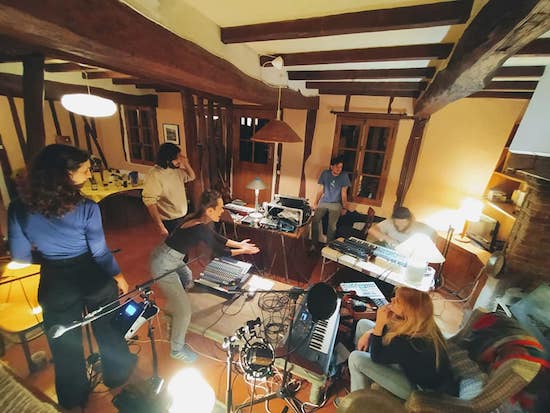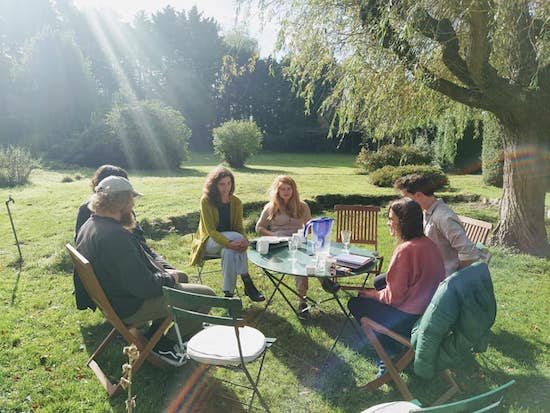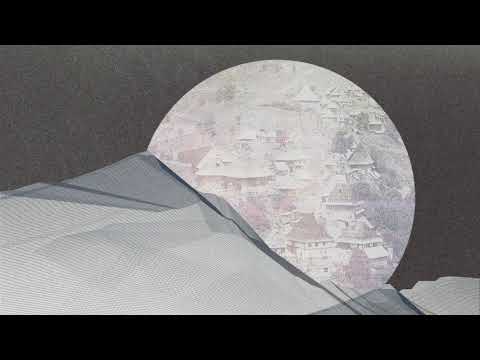I connect to Zoom for my interview with Çhâñt Élečtrónïqùe expecting to speak to maybe two or three members of the eight-strong, multi-national collective. Instead I’m greeted by seven people who are arrayed – some crouching, others standing – around a screen in the garden of a country house in Normandy.
I recognise a few faces: Louise Calzada, Nils Peschanski and Raphael Hardy I know from their days in the sadly defunct, French experimental pop group Le Vasco. Then there’s Darragh Quinn, from Ireland but based in Strasbourg; Nenad Kovačic, a producer and percussionist from Croatia; singer Dunja Bahtijarević from Croatia and Bosnia; and Teresa Melo Campos, a singer from Portugal – only Argentinian Helena Helft is missing.
As initially bewildering as this arrangement is, I quickly accept that the multiplicity of voices is also entirely appropriate.
Their debut album, çhâñt élečtrónïqùe vol. 1, which is being released on a new London and Zagreb based label called Rika Muzika (Kovačic is involved in various projects in Croatia with composer and label co-founder Mak Murtić), is the product of conversations and a residency in which they worked on a fusion of traditional songs from various traditions, polyphonic singing and, for want of a better term, ‘contemporary’ production. And this group of singers and beatmakers has not only sidestepped the potential pitfalls of such an endeavour but also produced something of uncommon and frequently exquisite beauty.
It’s tempting to describe it as miraculous, but it’s clear from our conversation just how much reflection and work has gone into achieving these ends, from the lilting but driving ‘Maiz de Viracocha’ to the beatless tidal wave that is ‘Senhora das Aguas’.
What has brought you together in Normandy?
Darragh Quinn: Well this is our second residency. We came together last October in Portugal. Our initial idea was to explore how traditional music and electronic sound could interact. We made a compilation album and finished it during the year thanks to lockdown. We’d planned for months to meet up again this time of year to do another edition and continue our research or experiments.
Who initiated the meeting in Portugal?
DQ: Nils and I talked about this idea for a while, we met on an exchange programme for traditional musicians called Ethno. Nils has helped me to get into the world of electronic music, and we talked a lot about how it could be cool to explore what seemed like opposing musical worlds. We didn’t really know how we could do it and I think we were in a bakery and Teresa overheard us excitedly talking about this idea and was like “I want to help with this!”
Was that your first encounter with Teresa?
DQ: She works in the bakery! No, she was in the group, we were buying croissants and she said, “That sounds really interesting and maybe we could do it in Portugal”.
Teresa Melo Campos: We went to the countryside, the same way as we’re doing now, and it’s us as a collective having discussions for around ten days, where you can get deeper into these conversations – why are we all here and what are we looking for individually but as a collective as well, sharing tools and knowledge of traditional music and electronics.
The results are beautiful but, on paper, a mix of traditional song and ‘modern’ beats looks like something with the potential to be dreadful. What kinds of conversations do you have about how making this work?
Louise Calzada: We really talked a lot about how to proceed, trying to conceptualise what drives us. The process for the first residency was for the singers to bring traditional songs and present them, and then we make up duos and trios to work on them. We try to talk about what it means, what emotion it shares and try to go to some meaningful concepts and then produce something with them.
TMC: We have collective discussions about where the song is from and what it reflects about the culture of the person who brought it, or what it meant some time ago, or which context it comes from. And then if you feel like working on that type of subject or that type of discussion, the duos or trios with both singers and producers continue that same conversation until they discover which tools to use.
Part of the reason why these productions work I think is that you’ve focused on two main elements – the voice and the rhythms. There isn’t a lot of extraneous instrumentation. Was that a deliberate decision?
LC: I think it was, as an example of that we played a show in Porto at the end of the first residency and it was only polyphony and percussion. I think we chose that because it’s something we really like, a taste we have in common.
Nils Peschanski: At the beginning we were talking about this with Dara and I think Teresa and Nenad were already around. We thought about gathering in Porto and who would be interested, who would be nice to invite, I think we were all on the same page about the aesthetics and what we like in traditional music. Because sometimes traditional music can be quite cheesy if it’s done in a certain way, but I think we share some common tastes and that’s what brought us all together.
TMC: And also I think the basis of traditional music would be voice and drums, using your own body as an instrument and a drum with animal skin, which would be the primitive elements.
How many different languages or cultures are you drawing from?
TMC: On the album we have released it’s from Argentina, an Aymara song (the Aymara are an indigenous minority in Argentina), from Portugal, from Croatia and Bosnia. For the next album it might change. We’re thinking about that now – if we sing traditional songs from other countries, what would that mean? What does that bring to the discussion?
Are there common themes in the songs?
DQ: I think in terms of traditional music across the globe we’re learning that there are these really universal themes, these aspects of humanity that pop up in Croatia, in Portugal and in Argentina – we’ve got a lot of love, a lot of war, a lot of working songs, functional songs. And it’s amazing to really unpick how these songs, in a completely different language on the other side of the globe, are talking about the same thing.
TMC: I think it’s always a mix of searching for what brings us together, what we share as themes, and also highlighting what might be specific in each song.
DQ: And we’ve just been talking a lot about how these songs still resonate today. They’re so old and there’s a reason why they’ve survived to the point that we still know about them. And in relatively extreme times like now, it’s amazing some of the links that are popping up with a wartime song from Bosnia that’s super old, which is talking about what we’re living through now in lockdown, and the language our governments are using to describe this as a wartime situation. It’s a testament to the fact that these songs have kernels of universal wisdom and humanity in them.
How have you been collecting the songs?
Dunja Bahtijarević: I’m from Croatia, born in Bosnia, and for me, and I think it’s the same as the other singers as well, it’s a lifelong process. Some are from childhood, some are from archives, some from teachers and other traditional singers, then we choose different songs from different projects depending on what the context and what the idea is. For me it’s really important in this group that all of us are really open to discussing the songs and meanings and depths, then I choose the most experimental songs or ideas for this group because I feel there will be a good response and a good chance that the end product is going to be something that I would be happy with.
Research has been done to demonstrate that work songs aren’t purely about giving a rhythm to labour, there can be more going on.
TMC: Yes I think that’s particular to traditional music, that the object is not the music itself. It has the function of accompanying something else, so it might be work or movements but it might be tiredness or lulling a baby, so in a way it’s the idea of functionality, it’s always helping something else.
DB: And also in Croatian traditional songs, they can be very rhythmical and repetitive but then the lyrics have nothing to do with work. You see that from how long and how repetitive they are that they have to be related to work, and then ethnomusicologists tell you that yes they were singing this while they were doing task, but the lyrics are bits and pieces of love life and social life and drinking – it’s never a full story, it’s just different images going one after another.
Have you learned things that you didn’t expect in the process?
DQ: I think one of the key things we learned is that we all have varying vocabularies for things that we all feel that we know about. And I feel we’re learning to think about production in a much less technical way and in a much more meaningful way – we have so many tools we can use in our world of electronics that it’s almost a problem. We’re trying to choose the tools that will be most useful to tell the story that we need to tell with each song. That way of thinking about production was a very new thing for me and seems like such an important thing to have learned.
The integration of acoustic percussion with programmed beats works really well.
LC: Using the traditional percussion we are really searching for ways to play with a tempo-based, fixed grid. Because it’s really not the groove that we hear when Helena or Teresa play their percussion. To just transfer it into electronic, programmed percussion didn’t work because of these really small variations in groove that are very human. So how we can play with that electronically?
NK: And also with percussion it depends very much on how we record it – technical things like where to put mics, which mics, and extended techniques for playing stuff, using them in unexpected ways.
So where was the actual recording done?
DQ: In a little country house in Portugal, in a bedroom with a little balcony.
DB: And outside also!
You can hear some of that outside ambiance on the recordings.
DQ: Yeah we sampled loads of sounds, it’s a particular interest of mine – I come originally from a traditional music background and there are certain things in electronic music that kind of annoy me, so I wanted to explore how organic sounds could be used in that context. We sampled a lot of sounds of woods and gates and cornfields, and then we used them creatively.
TMC: Yeah I think we both used soundscapes to create groove and also we use electronics to create soundscapes. I think it has to do with the fact that traditional music always used to happen surrounded by a context and to serve a function. So in a way it’s important to use the context to generate the music.

Is being in a collective better than being in a band?
TMC: We’ve been saying “are we a band?”! I think collectives are wider – a collective can be a band, but a band might not be a collective. I don’t know if it’s better.
DQ: I think there’s definitely a certain freedom in a collective. For example, Helena from Argentina can’t make it but we can still function as a collective. And we’ve talked about the fact that just three of us could do concerts in a certain place, we could work as a trio or a duo. So I think it give you this possibility to have different arrangements of the group. Also it doesn’t have the expectation of the audience that they’re going to see everyone in this band, and that maybe there’s a guest joining them. Although in terms of commitment, it’s a band, and it takes that amount of time, but we still have that freedom.
TMC: A band is more associated with a musical vision, and a collective might be an idea.
NP: I think you’ve just had a perfect example of why it’s a collective because we always speak together!
We can’t really avoid talking about Covid, and I guess this flexibility is going to be really important now.
DB: This is a good example of how committed we are, in Covid times it’s difficult to travel and we actually met up here –
Nenad and I were driving for two days to get here.
DQ: And I think in these times it’s become politicised, making these projects is a political act. Because we’ve been told it’s not of any worth and that like Fatima we should retrain in ‘cyber’. So the fact that we’re here together and we’ve managed to do this is, for me – and I think I speak for all of us – really important.
TMC: And I think it shapes what we are discussing, and which songs we’re choosing.
In what way?
TMC: There is a Portuguese song that I brought, it’s like a working song by an important songwriter called José Mário Branco. You have a clear soloist, or a voice that is a vehicle for communicating for a group of people and it’s about standing up and continuing to move, focusing on your idea, planting seeds in the soil – there’s a parallel between nature and making things grow, and people and ideas and growing collectively. There is a solo voice and there is this bass with voices under the soloist, and you feel it could be a work song where all the other voices are kind of keeping the tempo or the rhythm going but it grows to a point where you’re not sure if everything will go the right way or not.
DQ: Another example is the Violeta Parra song – she was a Chilean song collector and tragically took her own life at the age of 28. She tried to speak truth to power, fighting for justice for mine workers, for people who didn’t have access to really basic things at the time.
TMC: She didn’t have the possibility of living her life just by collecting songs and sharing them so she killed herself when she was very young.
DQ: And when you listen to the recording of the song, she has a kind of detached attitude of ‘I’m speaking the absolute truth here, whether you listen to me or not does not change the fact that it’s the truth’. And Louise made the point that when we have heads of state who are peddling blatant untruths, it seemed to resonate that you have this woman from Chile saying ‘no matter what you say, the truth is the truth.’




